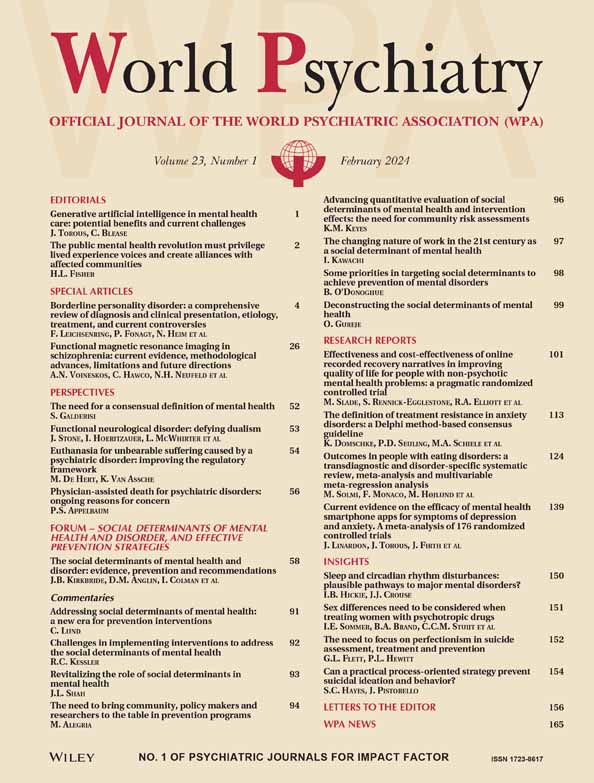WPA Position Statement on Recruitment in Psychiatry
IF 65.8
1区 医学
Q1 PSYCHIATRY
引用次数: 22
Abstract
The problem of recruitment in psychiatry is universal. There are very few countries where this problem does not exist. Variations have to be seen in the context of health care systems, training options and educational systems. The World Health Organization has set a target of one psychiatrist per 10,000 population globally. While this target is met in most European countries, North America and Japan, just under half of the world population live in countries with less than one psychiatrist/100,000 population. The rates are extremely low throughout Africa, and low in South America, Southeast Asia and Subcontinental Asia, with high urbanrural disparity. Despite the relatively high numbers of psychiatrists, many high-income countries are suffering from a perceived “recruitment crisis”. In many countries vacancy rates in training posts remain over 10%. To complicate matters further, often international medical graduates who may see psychiatry as popular take up much of the slack, contributing to “brain drain” from their countries of origin. Who chooses psychiatry, and what influences their choice? Many students choose medicine for the specific purpose of doing psychiatry, but some change their mind during their training. Others see the process through. Some students fall into psychiatry either passively or choose it actively. The reasons are often complex. Most of the studies have focused on understanding issues in Europe and the US. As duration of undergraduate training in psychiatry varies from 2 to 8 weeks, it is important to explore and understand these variations. WPA studies have shown that female doctors are slightly more likely to choose psychiatry. A personal or family history of mental illness increases the likelihood of choosing psychiatry. Medical students with undergraduate exposure to psychology or social sciences are more likely to choose psychiatry. Having a positive experience of psychiatry teaching and placement with clinical activities and exposure to psychotherapy during medical school, and/or additional exposure through clinical electives, also influence the choice of psychiatry. What factors negatively influence recruitment? A fall in levels of interest in psychiatry during undergraduate training can be attributed to poor exposure to teaching, a lack of psychiatric facilities and limited clinical exposure. Furthermore, the quality of mental healthcare in many parts of the world is extremely poor, and largely inpatient, with little opportunity for exposure to community-based psychiatry or other specialities. As such, students may be turned off psychiatry by what they witness during placements. The relative lack of financial reward can also affect career choice. Other factors are stigma against the psychiatric profession and against mental illness in general, resulting in perception of psychiatry as unscientific, ineffective, or apart from mainstream medicine. There is a perceived lack of respect from colleagues in other specialities and a poor public image. Furthermore, misconceptions and prejudices against the mentally ill themselves may make psychiatry an undesirable proposition. The stereotypes of psychiatric patients being dangerous or unpredictable and chronicity of psychiatric disorders can also put medical students off psychiatry. How can recruitment be improved?WPA关于精神病学招聘的立场声明
精神病学的招聘问题是普遍存在的。很少有国家不存在这个问题。必须在医疗保健系统、培训选择和教育系统的背景下看待差异。世界卫生组织设定了全球每10000人中有一名精神病学家的目标。虽然这一目标在大多数欧洲国家、北美和日本都实现了,但世界上不到一半的人口生活在每10万人口中只有不到一名精神病学家的国家。整个非洲的发病率极低,南美洲、东南亚和亚大陆的发病率也很低,城市差异很大。尽管精神科医生的人数相对较高,但许多高收入国家正遭受着一场被认为是“招聘危机”的困扰。在许多国家,培训职位的空缺率仍然超过10%。更为复杂的是,那些可能认为精神病学很受欢迎的国际医学毕业生往往会填补大部分空缺,导致原籍国的“人才流失”。谁选择精神病学,是什么影响了他们的选择?许多学生选择医学是为了学习精神病学,但也有一些学生在培训期间改变了主意。其他人看到了这个过程。一些学生要么被动地进入精神病学,要么主动地选择它。原因往往很复杂。大多数研究都集中在理解欧洲和美国的问题上。由于精神病学本科生培训的持续时间从2到8周不等,探索和理解这些变化很重要。WPA的研究表明,女性医生选择精神病学的可能性略高。有精神病史的个人或家族会增加选择精神病学的可能性。本科生接触心理学或社会科学的医学生更有可能选择精神病学。在医学院期间,有积极的精神病学教学和临床活动安置经验,接触心理治疗,和/或通过临床选修课额外接触,也会影响精神病学的选择。哪些因素会对招聘产生负面影响?本科生培训期间对精神病学的兴趣水平下降可归因于教学接触不足、缺乏精神病设施和临床接触有限。此外,世界上许多地区的精神卫生保健质量极低,而且大部分是住院患者,几乎没有机会接触社区精神病学或其他专业。因此,学生们可能会因为实习期间所目睹的情况而对精神病学产生反感。相对缺乏经济奖励也会影响职业选择。其他因素是对精神专业和一般精神疾病的污名,导致人们认为精神病学不科学、无效或脱离主流医学。其他专业的同事都认为他们缺乏尊重,公众形象也很差。此外,对精神病患者本身的误解和偏见可能会使精神病学成为一个不受欢迎的命题。对精神病患者危险或不可预测的刻板印象以及精神障碍的长期性也会让医学生放弃精神病学。如何改进招聘?
本文章由计算机程序翻译,如有差异,请以英文原文为准。
求助全文
约1分钟内获得全文
求助全文
来源期刊

World Psychiatry
医学-精神病学
自引率
7.40%
发文量
124
期刊介绍:
World Psychiatry is the official journal of the World Psychiatric Association. It is published in three issues per year.
The journal is sent free of charge to psychiatrists whose names and addresses are provided by WPA member societies and sections.
World Psychiatry is also freely accessible on Wiley Online Library and PubMed Central.
The main aim of World Psychiatry is to disseminate information on significant clinical, service, and research developments in the mental health field.
The journal aims to use a language that can be understood by the majority of mental health professionals worldwide.
 求助内容:
求助内容: 应助结果提醒方式:
应助结果提醒方式:


